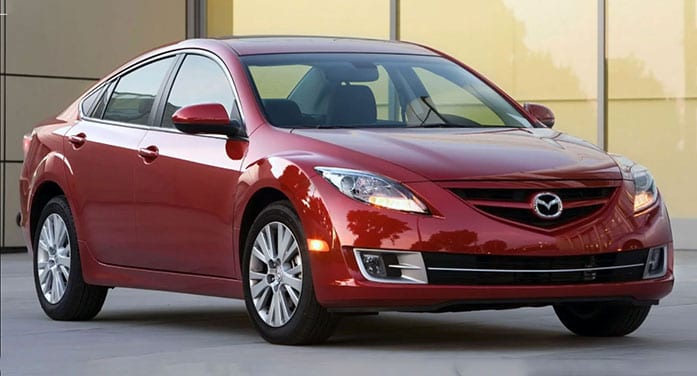 Overhauled, restyled and re-engineered in 2009, the 2010 edition of the Mazda6 was also on the receiving end of refinements and various upgrade of a comparatively minor nature.
Overhauled, restyled and re-engineered in 2009, the 2010 edition of the Mazda6 was also on the receiving end of refinements and various upgrade of a comparatively minor nature.
Some models got a push-button start feature, while others featured a blind spot monitoring system. But for all intents and purposes, the 2010 and 2009 Mazda6s were kissing cousins.
There were two engine choices: a 2.5-litre four cylinder and a 3.7-litre V6, with two basic trim levels: GS and GT. The four cylinder developed 170 horsepower, while the V6 churned out 272 horsepower.
Depending on the model, you could choose a six-speed manual or five-speed automatic transmission.
Standard equipment level was high and included things like air conditioning, one-touch-down power front windows, cruise control, power door locks, steering-wheel-mounted audio controls and tilt-telescoping steering.
Safety equipment included a full roster of front and side airbags, and four-wheel disc brakes with an anti-lock system. Options included leather interior, heated front seats, satellite radio and exterior “puddle” lamps.
Compared to one of its fiercest rivals – the Honda Accord – the Mazda6 featured a slightly larger trunk, but otherwise, these two were pretty close, dimensionally. And, unfortunately, the four-door hatchback and station wagon versions were no longer available.
Transport Canada showed two safety recalls for this iteration of the Mazda6. One concerned door latches that may not close and/or lock properly, causing the interior courtesy light to remain illuminated and, over time, drain the battery. The recalcitrant doors may even open inadvertently while the car is in motion. The other recall involved a possibly glitchy fuel supply system that could affect evaporation recovery components. Both were easily rectified by dealers and affected 2009 and 2010 models.

Overhauled, restyled and re-engineered in 2009, the 2010 edition of the Mazda6 was also on the receiving end of refinements and various upgrades
To this we can add 13 technical service bulletins from the U.S. National Highway Traffic Safety Administration (NHTSA) covering everything from condensation inside the headlights, to inoperative rear doors locks during cold weather or immediately after a car wash, to missing floor-mat hooks, to water coming in from the front passenger compartment roof pillars.
NHTSA also had 17 consumer complaints registered for the 2010 Mazda6. Issues with the brakes and lighting seem to be the most common. A sampling:
- “while driving at various speeds, the vehicle accelerated independently;”
- “the (brake) rotors are warped after less than 30,000 kilometres;”
- “the inner tail light lenses on both the driver and passenger side of the vehicle are physically melting.”
Despite good marks in most areas from Consumer Reports, the 2010 iteration of the Mazda6 only rated an “average” used car prediction, down a notch from 2009. Problem areas included the braking system and mysterious squeaks and rattles.
As well, noted CR “the V6 is quick but thirsty.”
Some comments from owners:
- “seats are very roomy and comfortable;”
- “very Germanic handling, tight and responsive;”
- “a real ‘rocket’ for a little money;”
- “I get between 25 and 31 mpg (11.4 litres/100 km to 9.2 litres/100 km).”
Marketing researcher J.D. Power, meanwhile, gave the ’10 Mazda6 a below-average grade for overall quality and just average marks for overall dependability, performance and design. Powertrain quality, body and interior dependability, and body and interior mechanical quality were areas of concern, according to this organization.
While it can’t match the V6 in terms of performance, all things considered, the four-cylinder version of this car is probably a wiser choice than the V6 – at least in terms of operating costs and fuel economy. The V6 also featured a much harsher ride than its four-cylinder stablemate.
From an original base price in the low $20,000 neighbourhood, the 2010 Mazda6 now seems to be going for as low as $5,000 to $8,000, to around $10,000 to $12,000 – depending on trim level and mileage, of course.
2010 Mazda6
Original base price: $23,195
Engine: 2.5-litre four cylinder and 3.7-litre V6
Horsepower: 170 and 272
Torque: 167 and 269
Transmission: Six-speed manual or five-speed automatic
Fuel economy (litres/100 km): 9.7 city and 6.7 highway, four cylinder with manual transmission, using regular gas
Alternatives: Honda Accord, Toyota Camry, Hyundai Sonata, Chevrolet Malibu, Nissan Altima, Dodge Avenger
Ted Laturnus has been an automotive journalist since 1976. He was named Canadian Automobile Journalist of the Year twice and is past president of the Automobile Journalists Association of Canada (AJAC). For interview requests, click here.
The views, opinions and positions expressed by columnists and contributors are the authors’ alone. They do not inherently or expressly reflect the views, opinions and/or positions of our publication.
© Troy Media
Troy Media is an editorial content provider to media outlets and its own hosted community news outlets across Canada.



